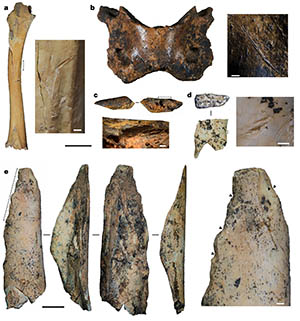High up on the Tibetan Plateau, inside the Baishiya Karst Cave, a fascinating story of ancient human survival unfolds. A recent study reveals that the Denisovans, an extinct human species, called this place home for countless millennia.
Aside from their notable genetic contributions to modern humans, very little is known about the Denisovans.
Somehow, these enigmatic early humans adapted to the harsh high-altitude conditions of the Tibetan mountains, leaving behind clues that give us a captivating glimpse into their way of life and resilience.
Who were the Denisovans?
Remember them from science class? They are an extinct species from our ancient lineage that lived on Earth with us, Homo sapiens, and our other long-extinct cousins, the Neanderthals.
But unlike the Neanderthals, the Denisovans are more mysterious. We have so far found only a few fragments of their puzzling existence.
The mystery deepened with an incredible discovery made by a determined international research team.
Their goal? To probe more than 2,500 bone remains discovered in the Baishiya karst cave, one of only two known Denisovan habitats.
New findings raise more questions
Published in the NatureTheir fascinating analysis identifies a recent Denisovan fossil. It also illustrates the incredible resilience of the species in the face of fluctuations in climatic conditions, including the Ice Age.
Think about it: our predecessors survived on the Tibetan Plateau about 200,000 to 40,000 years ago. Can you imagine that?
Dr Geoff Smith, a zooarchaeologist at the University of Reading and co-author of the study, said he was excited by their findings about Denisovan behaviour.

The research team found evidence of the diverse diet of this ancient human species.
“We were able to identify that the Denisovans hunted, slaughtered and ate a range of animal species,” Dr Smith explained.
He also stressed the importance of their findings, noting that the study provides insight into how Denisovans adapted to harsh environmental conditions.
“We are only just beginning to understand the behavior of this extraordinary human species,” Dr. Smith concluded, emphasizing the nascent state of our knowledge about this species.
Discover the details of the life of the Denisovans
The bone remains were broken into many fragments, making them very difficult to identify. However, the team developed a new scientific method to determine which species the bone remains belonged to. It uses differences in bone collagen between animals.
Dr Huan Xia from Lanzhou University sheds light on this innovative technique: “Zooarchaeology by mass spectrometry (ZooMS) allows us to extract valuable information from often overlooked bone fragments, providing deeper insights into human activities.”
The introduction of ZooMS represents a leap forward in archaeological studies. This cutting-edge technique allows scientists to extract identifiable collagen peptides from tiny bone fragments, transforming a previously obscure and complicated puzzle into a clearer picture of the past.
The researchers found that most of the bones belonged to blue sheep (bharal), wild yaks, horses, the extinct woolly rhinoceros and the spotted hyena. There were also bone fragments from small mammals, such as marmots, and birds.
“Current evidence suggests that it was the Denisovans, and not any other human group, who occupied the cave and made efficient use of all the animal resources at their disposal throughout their occupation,” said Dr Jian Wang of Lanzhou University.
The Denisovans were inventive and resilient
Moreover, the researchers’ careful analysis of the fragmented bone surfaces indicates that the Denisovans did more than just hunt these animals. They also transformed their remains into useful tools.
The team identified a rib bone, dating to between 48,000 and 32,000 years ago, as belonging to an unknown Denisovan individual.
This person lived at a time when our ancestors, modern humans, were beginning to spread across the Eurasian continent.
Researchers believe that the Denisovans survived two cold periods, as well as a warmer interglacial period between the Middle and Late Pleistocene epochs.
Together, the fossil and molecular evidence indicates that the Ganjia Basin, where the Baishiya karst cave is located, provided a relatively stable environment for Denisovans, despite its high altitude.
Dr Frido Welker of the University of Copenhagen leaves us with a lingering question: “The question now arises as to when and why these Denisovans of the Tibetan Plateau disappeared.”
Consequences for modern human society
In short, this latest discovery raises a wave of new questions. Why did these resilient beings disappear? What lessons can we learn from their survival in a changing climate?
The insights gained from studying Denisovans resonate with some of today’s most pressing issues. In today’s world, where climate change is altering environmental parameters at an unprecedented rate, understanding how Denisovans have adapted to severe climate fluctuations could provide valuable lessons.
Their ability to withstand harsh conditions at high altitude reflects the contemporary challenges faced by communities in similarly extreme environments.
Reflecting on their ingenuity and resilience, we might draw parallels with the importance of sustainable living and adaptation strategies.
As we delve deeper into the remains of these ancient men, we may discover more than just traces of our genealogy. Perhaps we will find a guide to our future.
The Tibetan Plateau Research Institute, CAS, China, also contributed to this study.
The full study was published in the journal Nature.
—–
Like what you’re reading? Subscribe to our newsletter to receive interesting articles, exclusive content and the latest updates.
Check us out on EarthSnap, a free app from Eric Ralls and Earth.com.
—–